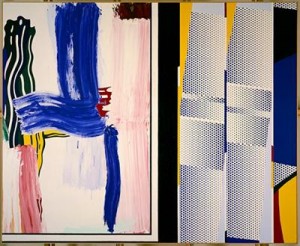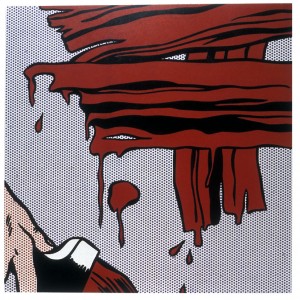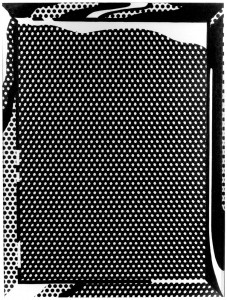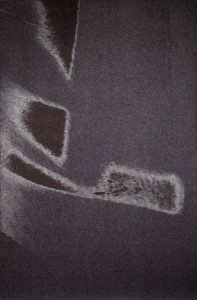
Roy Lichtenstein. "Paintings: Mirror," 1984. Oil and Magna on canvas. 70 x 86 inches. Courtesy the Roy Lichtenstein Estate and the Leo Castelli Gallery.
“People are always calling me a mirror, and if a mirror looks into a mirror, what is there to see?” – Andy Warhol
In the current exhibition at the Leo Castelli Gallery, there is a work by Roy Lichtenstein titled Paintings: Mirror. The work is a centerpiece of “Reflected in the Mirror There Was A Shadow,” a small yet electrifying exhibition that brings together a selection of Roy Lichtenstein’s Mirror paintings and Andy Warhol’s Shadow canvases. As its title suggests, Lichtenstein’s Paintings: Mirror is really a diptych: the left side of the work represents the surface of a canvas, while the right hand side is the mirror. Lichtenstein has covered the “canvas” side with broad, gestural brushstrokes reminiscent of those by Willem de Kooning, Franz Kline and other Abstract Expressionists. Pop artists made something of a habit of lampooning the bravura brushwork of this previous generation, parodying their lofty aspirations to achieve authentic and unique artistic expression through the liberating excess of their painterly marks. Lichtenstein’s Paintings: Mirror seems to fit neatly within this critical tradition of Pop. But here is where it gets interesting.
For such a parody, the obvious, even expected maneuver would be to have the right register of Lichtenstein’s Paintings: Mirror diptych, the mirror side, contain Pop-infused, stylized brushstrokes that mimic the expressive, dripping ones on the left—reflections drained of any expressiveness, reflecting and restating the bravura brushwork but with a decidedly commercial rather than personal origin. Having one side comprised of the gestural brushwork that has become the sign of Abstract Expressionism and the other a stylized Pop rendition of them would be an easy send-up, a one-note parody of Action Painting’s intent and incident. Indeed, Lichtenstein began doing just such parodies of brushstrokes as early as 1965, and continued to do so throughout the remainder of his career.

Roy Lichtenstein. "Brushstrokes," 1965. Oil and Magna on canvas. 48 x 48 inches.
Mirrors first appeared in Roy Lichtenstein’s paintings in 1961, but it wasn’t until the 1970s that they became in his art something of a motif unto themselves. Using imagery often culled from commercial mirror advertisements, Lichtenstein distills the mirror—one of the most enduring motifs in the history of art—through his Pop Art concern with consumer culture and mass media. By 1969, with Lichtenstein’s Mirror #1, the artist’s representation of a mirror seems to have merged with the canvas itself, as the mirror’s reflective surface stands in for the entirety of the canvas, the mirror’s bevel seemingly becoming the frame of the painting itself.

Roy Lichtenstein. "Mirror #1," 1969. Oil and Magna on canvas. 24 x 18 inches. Courtesy the Estate of Roy Lichtenstein and the Leo Castelli Gallery.
But in Paintings: Mirror, the bravura strokes of Abstract Expressionism and their stylized Pop iteration are on the same side of the painting’s divide. Here, both apparently succumb equally to the reflection of the mirror, a reflection that re-presents them both as a dense, almost totally abstract array of Ben Day dots and bands of primary colors (the telltale signs of representation made transparent). Both styles have been impersonally rendered through Lichtenstein’s meticulous duplication of the look and techniques of commercial illustration. But what does it mean when the expressionistic brushstroke—marks of a unique self—and the depersonalized Pop brushwork—marks of the erasure of that self within the economy of late capitalism—are not located in some dialectical tension, but are in fact both seen to be withering before their reflection in the mirror? An answer might be found, I think, by considering what his Mirrors and Warhol’s Shadow paintings have in common—a connection that is the structuring principle of the Castelli exhibition.

Andy Warhol. "Diamond Dust Shadow," 1979. Acrylic, diamond dust and silkscreen on canvas. 78 x 50 inches. Courtesy the Louisiana Museum of Modern Art, Denmark.
In 1978–79 Warhol produced an extraordinary series of work in which shadows themselves became the subject his silkscreened paintings. The series is punctuated by a cycle of shadow paintings consisting of 102 individual canvases, but considered one massive environment piece (owned by the Dia Foundation). Unlike the familiar clarity that defines much of the imagery in Warhol’s oeuvre, Warhol’s shadows refuse to take definitive shape or to yield some knowable underlying object of which they are an indexical trace.
In this exhibition’s juxtaposition of Lichtenstein’s Mirrors and Warhol’s Shadows, we are confronted with somewhat anomalous moments in the oeuvres of Lichtenstein and Warhol. Rather than veering the viewer’s experience towards entertainment (comic books, pulp fiction) and spectacle (pop melodramas, celebrity), that is, rather than grounding their work in straightforward Pop terms of questioning the status of representation in an era of late capitalism, both artists instead foreground “objects”—reflections and shadows—whose constitutive source is present precisely through its absence.
Here there are no canvases of Marilyn, Elvis or Campbell’s soup cans, no excerpts from period action comics or pulp fiction melodramas. In fact, unlike much of their previous work, Lichtenstein’s mirrors and Warhol’s shadows have no obvious pop cultural reference, or any clear connection to commercial or consumer sources. But as eccentric as the Mirrors and the Shadows might seem to Lichtenstein and Warhol’s respective oeuvres, these series of works might instead be better situated at the center of their practices, as these seemingly atypical motifs can be seen to closely correspond to the ontological condition of Pop Art as defined by Roland Barthes.
“What Pop art wants,” Roland Barthes wrote in 1980 in “That Old Thing, Art…” “is to desymbolize the object,” by which he means that Pop seeks to unhinge its objects from any deeper meaning.[1] But this is not to say that the Pop object is meaningless. To the contrary, Barthes concludes that pop objects do signify: “they signify that they signify nothing.” For Barthes, the essence of the Pop object is how it marks the complete integration of art into the economy of the sign, declaring itself as nothing other than a sign. It is “an object,” Barthes concludes, “which is neither the thing nor its meaning, but which is: its signifier, or rather: the Signifier.”[2] This condition of Pop art might also be seen as the condition of Warhol’s Shadows. After all, a shadow signifies, just signifies. Warhol’s shadows resist being read indexically and defy symbolization, instead merely calling attention to its precarious condition again and again as merely an empty sign, unhinged from any knowable source and monumentalized to the status of an art object itself—to the status of Art.
Like shadows, mirrors are also precarious objects, as they do not contain or present anything in its fullness, they merely repeat an appearance, reflecting and reproducing in their surfaces a semblance of whatever is before them. Warhol once coolly remarked, “If you want to know all about Andy Warhol, just look at the surface of my paintings and films and me, and there I am. There’s nothing behind it.”[3] By elevating shadows and mirrors to the status of objects in their own right, Warhol and Lichtenstein both suggest, perhaps more certainly than they ever had before, that there is indeed nothing else behind “it,” behind representation, behind that old thing, Art.
“REFLECTED IN THE MIRROR THERE WAS A SHADOW: Roy Lichtenstein – Andy Warhol” is on view at The Leo Castelli Gallery until December 23, 2011.



